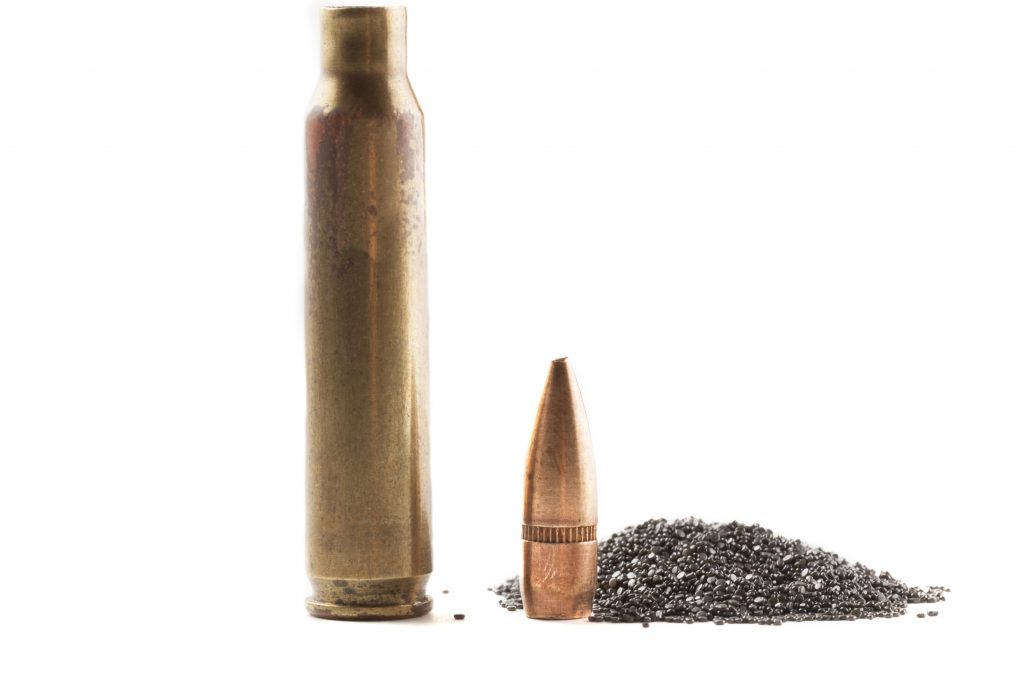RELOADING PROCESS STEP BY STEP
1. Clean your brass in a tumbler, wipe cases clean with a soft cloth, and inspect all brass for splits, cracks, or bulging. Any defective cases should be bent with pliers, and thrown away.
2. Clean inside of brass case with a case neck brush; add a light coat of case lube to aid in ease of resizing. Also lube the outside of the case. One Shot aerosol spray lube works great for this.
3. Install the correct shell holder and sizing die into the reloading press. The shell holder grips and holds the case. The sizing die is threaded into the reloading press until the die touches the shell holder with the ram/handle at the top of the press stroke. Raise the handle and turn the die down 1/4 turn and set the locking ring.
4. Insert the case into the shell holder, and resize the case by lowering the press (ram) handle and running the case up into the sizing die. The case will be resized to its correct dimension and will also push (decap) the spent primer. When the ram handle is raised, the case is lowered, and the expander ball (in the die) comes out, expanding the case-mouth.
5. Check case length and trim the case when needed. Cases will always stretch, becoming longer after several firings, you must check the length and trim to size for proper chambering and safety.
6. Chamfer and deburr each case, inside and out, after each trimming to remove any burrs; this process bevels the case for easier seating of the bullet.
7. Prime the case, inserting primer into bottom of case. A good way is to use a hand held priming tool to insert primers into the case. This provides a better feel for the primer being inserted. The other method is to use the reloading press and a priming tool attachment for seating primers.
8. Powder Charge: consult a reputable reloading manual and look up your load and learn which powder and what charge amount to weigh on your scale. DO NOT start at maximum load; rather start at 10% below the max and “WORK UP” to the Optimum Load. Put the charge into each case carefully using a powder funnel. Always inspect each case with a flashlight to insure even charges in each case.
9. Bullet Seating: thread the seater die into the press. Put your case into the shell holder and lower press handle, running the case to the top of the press stroke. Turn the die body down until it is touching the top of the shell holder (full contact). Back the die out Âź turn, raising the crimp shoulder above the case mouth. Secure the die with the locking ring.
10. Next, unscrew the seater plug to keep the bullet from being seated too deeply. With the ram handle in the up position, insert a properly primed and charged case into the shell holder, take a bullet and place it gently into the top of the case mouth, holding it with one hand. With the other hand, lower the press and raise the case and the bullet up into the die. The seating of the bullet will begin. Take note of seating depth of the bullet into the case, if the bullet needs further seating into the case, then turn the seater plug down Âź turn.
11. Run the loaded round up into the die, raise the ram handle and check the seating depth again. Keep repeating this process of adjusting the seater plug, and running the bullet into the die, and measuring seating it until you reach the proper seating depth. Once you do, tighten the lock ring on the seater plug. You are now ready to start reloading ammo, round by round.
12. Place each charged case in the shell holder, guide a bullet on top, and run the case and bullet up into the seating die, seating the bullet. Then check the seating of each bullet. Once the proper seating depth is reached, you are done!! You can load a box or as many rounds of ammo as you want.
Other articles: greatest door to door fundraising companies and hoop
